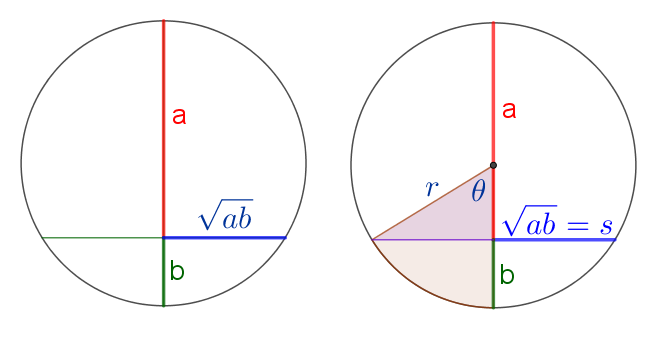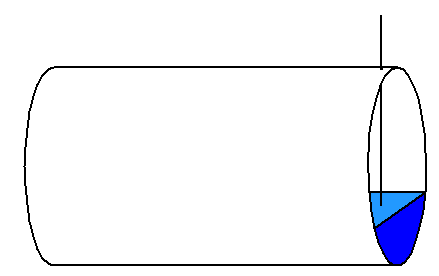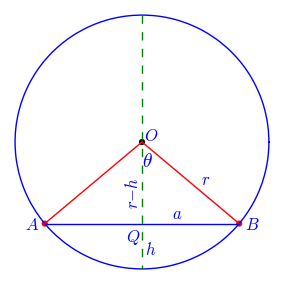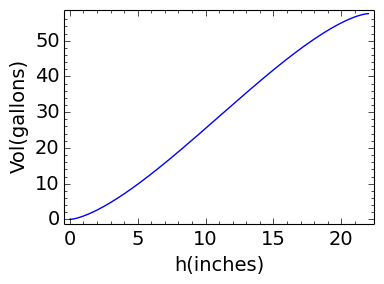Sector Area of a Circle
The formula for the area of a circle is known to be $\pi r^{2}$. Likewise, the length of a complete circular arc, that is, the angular distance all the way around a circle is known to be $2\pi$. This means that for an angle, $\theta$, which starts at the $x$-axis and goes all the way around until it arrives again at the $x$-axis, the angle, $\theta$, expressed in radians has a value of $2\pi$. That is enough information to set up a ratio to get the area of any angular sector for which we know the angle. $$\frac{\pi r^{2}}{2\pi}=\frac{Area_{sector}}{\theta} \tag{1} \label{1}$$
Geometric Mean
We know that the arithmetic mean is given by $\sum_{i=1}^{n}(a_{i})/n$. Less well known is a definition for a geometric mean which is defined to be the n-th root of the product of a list of numbers. $$\text{Geometric Mean}=\sqrt[n]{\prod_{i=1}^{n}a_{i}}=\left(\prod_{i=1}^{n}a_{i}\right)^{1/n}$$ Thus if we have a list, $L=(1,5,8,10)$,then the arithmetic mean is $$\text{Arithmetic Mean}=\frac{1+5+8+10}{4}=6$$ and $$\text{Geometric Mean}=\left(1\cdot5\cdot8\cdot10\right)^{0.25}=4.47$$

Proof: We will prove that the half length of a chord, which is divided by a circle diameter through the midpoint of the chord, has a leg length equal to the geometric mean of the divided diameter. That is, in the fig. we will prove that half of the chord length $=\sqrt{ab}$.
As labelled in figure 1, $b$ is the length along a diameter line from the chord to the circle. From the center of the circle to the chord must be distance $r-b$. Let $s$ be the half length of the chord. By Pythagoras, $$(r-b)^{2}+s^{2}=r^{2}$$ Expand: $$r^{2}-2br+b^{2}+s^{2}=r^{2}$$ and simplify $$b^{2}-2br=-s^{2}$$ $$s^{2}=2br-b^{2}=b(2r-b).$$ But $2r-b=a$, where $a$ is the length of the larger diameter part. So $$s^{2}=b\cdot a$$ $$s=\sqrt{ab}$$ The assertion is proved. $\square$


Solution: The volume of the tank is just its length, $L$, times the area of one end. Refer to Fig 3. From the right triangle, $OQB$, length a can be calculated from the Pythagorean theorem. $a=\sqrt{2rh-h^{2}}$. Then the right triangle area is $[(r-h)\cdot\sqrt{2rh-h^{2}}]/2$ and thus the entire triangle, $OAB$ has $area=[(r-h)\cdot\sqrt{2rh-h^{2}}]$. Also, angle ${\color{blue}\theta=\cos^{-1}(\frac{r-h}{r})}$, and the sector angle is $2\theta$. Now compute the sector area, and subtract triangle $OAB$ to get the area of the fuel against the end of the tank. $$\text{SectorArea ratio}\Rightarrow \frac{\pi r^2}{2\pi}=\frac{SectorArea}{2\theta}$$ $$Area=SectorArea-TriangleArea$$ $$Area=\frac{\pi r^{2}2\theta}{2\pi}-(r-h)\cdot\sqrt{2rh-h^{2}}$$ Substituting the value found for $\theta$ and simplifying, $$Area=r^{2}\cdot\cos^{-1}(\frac{r-h}{r})-(r-h)\cdot\sqrt{2rh-h^{2}}$$ And since volume is length times Area, $$Vol(h)=L\left[r^{2}\cdot\cos^{-1}(\frac{r-h}{r})-(r-h)\cdot\sqrt{2rh-h^{2}}\right]$$
